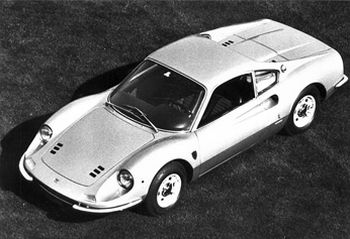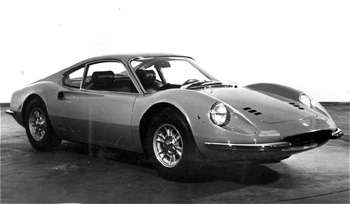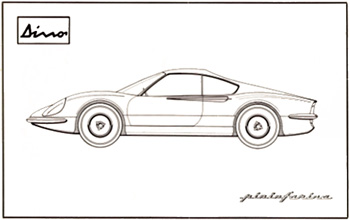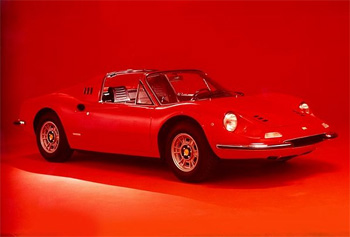The scheduled April production start was slightly
optimistic, with Dino 206 production eventually commencing
in the second half of 1968, the first car being s/n 00102
GT. The bodywork and trim were constructed at the Scaglietti
Modena factory, with the shells subsequently being
transported to Maranello to receive interior and
mechanicals.
Underneath the aluminum body, the Dino 206 featured a tipo
607 tubular chassis. Suspension, both front and rear,
was independent, with wishbones, coil springs, telescopic
shocks, and anti-roll bars. Stopping power was supplied by
large Girling discs. Under the bonnet, the mid-mounted
1987cc tipo 236/B engine was quoted by the factory as
producing 180 hp.
Just 99 206s were constructed in 1968, with another 51 built
in 1969 before production ceased in April with s/n 00404.
The 206 Dino was then succeeded by the first 246 Dino, s/n
00402; these early 246s are often referred to as "Series l" or "Type L" Dinos, the
"L" referencing the car's tipo 607 L chassis.
|
 |
|
Displayed
at the 1967 Frankfurt motor show, the "Dino
Berlinetta Prototipo Competizione Pininfarina"
was the most radical of all Dino prototypes, and
showed little resemblance to the production
car. |
|
|
Mistaken by many as the same car, the 246 actually differed
slightly from the 206. The front track remained the
same, although rear track was increased by 30mm. The wheelbase was increased by
60mm and the roofline was raised by 20mm. Front and rear
overhangs also grew by 10 and 20mm, respectively.
Unlike
the 206, the bodywork of the 246 was not crafted out of
aluminium, with steel being used mainly. Smaller
details were also changed, such as the fuel filler cap,
which received a circular cover door.
As
given away by the name, the biggest change was the tipo 236
E V6 engine. It now displaced 2418cc, thanks to its larger
(92.5 vs 86mm) bore and longer (60 vs 57mm) stroke. The
first 246s had three 40 DCNF 1 Webers, changing to 40 DCNF
7s at s/n 00530. Regardless of which carburetors were used,
the factory horsepower rating was 195 bhp @ 7600 rpm.
|
 |
|
The
Dino 246 Coupé was not only longer, but also slightly
higher than the 206 |
|
|

 |
|
Dino
206 GT, clean lines by Pininfarina |
|
The suspension
on the first 63 Type L Dino's (s/n 00402 to 00528) was
identical to the 206. On s/n 00530, the anti-roll bar
diamter grew from 13 to 16mm. In early 1971, the last of the
357 Type Ls (s/n 01116) was built, to be succeeded by
the "Series 2," or "Type M" Dino, the
first being s/n 01118. Like the L Series cars, the M Dinos
had the tipo 607 L chassis and the tipo 236 E engine. The Type M 246s were only built in the first half of 1971,
with just 506 being made.
With further refinements, the "Series 3" or
"Type E" 246 entered production the following
month, starting with s/n 02132. Air conditioning, optional
leather interior, and electric windows were offered,
followed by additional options in 1972.
|
 |
|
The Dino 246 GTS featured a one-piece vinyl removable top, which slotted in neatly behind the seats. A soft top was also available, which could be stored under the front lid to save interior space.
|
|
|
Introduced at
the 1972 Geneva Salon, the Ferrari 246 GTS boasted a
removable top. The lightweight, black vinyl top fitted
behind the seats, whilst a cloth top was also available
which fitted under the front lid.
Export to the US also started with the "Type E" model, with cars bound for the market receiving inlaid
reflectors, and the Plexiglas headlight covers removed.
In February 1974, the last of the 1,624 Type E 246 coupes
(s/n 07650) was assembled. The last 246 GTS, s/n 08518, was
manufactured in July. Total production volume of the 246 GTS
model totalled to 1,274 units.
Back
to page 1
|
|
|
|
![]()
![]()